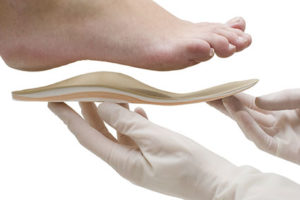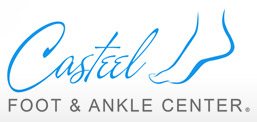One of the most common causes of heel pain can be heel spurs, also associated with strained ligaments and muscles in the foot. Repeated pressure or impact on the heel can result in excess calcium build-up on the heel bone, plantar fasciitis, fallen arches, tissue inflammation or Achilles tendon pain.
 Podiatrists see these conditions in experienced athletes, overweight individuals and sometimes just in people wearing poorly fitted shoes. No matter what the cause, heel spur pain can be debilitating. The good news is that pain relief can be as simple as adding padded insoles to your footwear.
Podiatrists see these conditions in experienced athletes, overweight individuals and sometimes just in people wearing poorly fitted shoes. No matter what the cause, heel spur pain can be debilitating. The good news is that pain relief can be as simple as adding padded insoles to your footwear.
Podiatrists can recommend specific orthotic devices, or “insoles” to specifically cushion and ease the pain of heel spurs. Buying generic over-the-counter shoe inserts without a full examination and diagnosis of your foot pain may set a patient up for failure. Insoles should not be expected to solve the problem when they are inserted in the patient’s existing shoes, which may be part of the problem.
Soft Padding Not a Solution
Many heel pain specialists note that their goals in prescribing insoles for heel spurs include correcting the distribution of pressure along the entire foot, strengthen ankle balance and ease the strain on feet, ankles and knees overall. Comfort from a soft generic insole may seem like a quick fix, but won’t treat the basic cause of heel spurs. Podiatrists focus on the whole package of feet, heels, orthotic insoles and shoes together for optimal pain relief.
Custom orthotics designed to help with heel spurs should work to ease pressure on the ligament by stretching and aligning the plantar fascia. Insoles can also work to improve shock absorption on the heel bone as you walk, run, exercise or stand for long periods. Heel spur orthotics are often prescribed by podiatrists along with effective non-surgical treatments like rest, anti-inflammatory medications, stretching targets muscle groups (feet, calves, plantar fascia), night splints, cortisone injections and other non-invasive therapies.
What to Expect from Custom Orthotics
Patients using insoles to relieve heel spur pain should allow time for the treatment to work, as with any medical procedure. The key is a good, well-fitted shoe with the correct type of insole that promotes proper posture, balance, walking gait and arch support.
A few tips include:
- Allow several days of continued wear to break in the insoles and shoes.
- Invest in shoes that offer correct arch support and heel cushioning specifically designed for the activity performed in those shoes.
- Inspect insoles for wear and tear over time, and replace if/when needed.
Insoles Offer High Success Rate
Reports indicate that more than 90% of heel spur and plantar fasciitis pain can be successfully treated nonsurgically with insoles/custom orthotics. Simple solutions from your podiatrist will help stabilize your foot, control pain, reduce inflammation and prevent reinjury to the heel.
Contact Casteel Foot & Ankle
Consult the heel spur specialists at Casteel Foot & Ankle Center to learn what type of orthotic insole is best for your individual condition. Call 972-412-4449 to schedule an appointment with podiatrists conveniently located to Rowlett, Rockwall, Garland, Royse City, Wylie and Forney.
